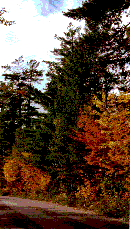

According to Native American myth, fall leaf colors resulted from the slaying of the Great Bear in the sky, whose blood dripped to the Earth and painted some eaves red. As the hunters cooked the bear meat, the splattering fat colored other leaves yellow.
 Chemical
processes, not freezing temperatures or frosts, cause leaves to change
color. Leaves contain several pigments that determine their
color.
The pigment seen normally during the summer is the green
chlorophyll,
which the tree uses to produce food from carbon dioxide and water using
sunlight. Chlorophyll is produced in deciduous trees
during the growing season, and masks the other pigments that may be
present.
Tree growth and chlorophyll production begins to slow own in the
fall as the number of daylight hours diminish and longer, cooler nights
arrive. When chlorophyll breaks down at the end of the growing
season,
the other pigments become more apparent and give the leaves their
fall colors. These other pigments that are produced in leaves
include
anthocyanins (reds) and carotenoids yellow/oranges).
Carotenoids
are always present in the leaves, while anthocyanins are produced in
some
species at the end of the growing season when food sugars become
trapped
in the leaves.
Chemical
processes, not freezing temperatures or frosts, cause leaves to change
color. Leaves contain several pigments that determine their
color.
The pigment seen normally during the summer is the green
chlorophyll,
which the tree uses to produce food from carbon dioxide and water using
sunlight. Chlorophyll is produced in deciduous trees
during the growing season, and masks the other pigments that may be
present.
Tree growth and chlorophyll production begins to slow own in the
fall as the number of daylight hours diminish and longer, cooler nights
arrive. When chlorophyll breaks down at the end of the growing
season,
the other pigments become more apparent and give the leaves their
fall colors. These other pigments that are produced in leaves
include
anthocyanins (reds) and carotenoids yellow/oranges).
Carotenoids
are always present in the leaves, while anthocyanins are produced in
some
species at the end of the growing season when food sugars become
trapped
in the leaves.
Trees showing red fall leaf colors include red maple, dogwood, sweetgum, blackgum, white oak, red oak, pin oak, scarlet oak, sourwood, sumac and sassafras. Certain ornamental varieties can produce extra-brilliant reds, such as the ‘Red Sunset’ and ‘October Glory’ varieties of red maple.
Trees with yellow leaf colors include birch, hickory, white ash, aspen, elm, beech, yellow-poplar, gingko, honey locust, and willow. Sugar maple is known for its showy orange-yellow colors, while baldcypress, a deciduous conifer, turns a spectacular gold.
Dry, sunny days and cool, but not freezing nights (below 45 degrees) during the fall bring out the most brilliant red leaf colors. Leaves with more direct sun exposure are more likely to turn red, while shaded leaves may be yellow. Leaf cells can be killed by frosts and freezing temperatures, causing the internal chemical processes that lead to fall colors to cease. Rainy fall weather can also lessen color intensity.
Consider adding a palette of colors to your yard. A mix of red, orange, yellow and green leaves (consider evergreen trees) in your landscape can be quite attractive. Select trees to plant that are healthy and well proportioned. Consider the tree’s mature size and available growing space (including overhead) when selecting a planting location. Plant after the leaves have begun to fall and before the ground freezes. Fall planting allows the roots to become established before spring leaf growth occurs. Give the tree plenty of water, but do not fertilize during the first year.
For more information, contact the Maryland DNR - Forest Service at 410-665- 5820 or 410-836-455.